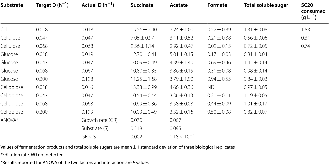A global analysis of gene expression in Fibrobacter succinogenes S85 grown on cellulose and soluble sugars at different growth rates
Cellulose is the most abundant biological polymer on earth, making it an attractive substrate for the production of next-generation biofuels and commodity chemicals. However, the economics of cellulose utilization are currently unfavorable due to a lack of efficient methods for its hydrolysis. Fibrobacter succinogenes strain S85, originally isolated from the bovine rumen, is among the most actively cellulolytic mesophilic bacteria known, producing succinate as its major fermentation product. In this study, we examined the transcriptome of F. succinogenes S85 grown in continuous culture at several dilution rates on cellulose, cellobiose, or glucose to gain a system-level understanding of cellulose degradation by this bacterium. Several patterns of gene expression were observed for the major cellulases produced by F. succinogenes S85. A large proportion of cellulase genes were constitutively expressed, including the gene encoding for Cel51A, the major cellulose-binding endoglucanase produced by this bacterium. Moreover, other cellulase genes displayed elevated expression during growth on cellulose relative to growth on soluble sugars. Growth rate had a strong effect on global gene expression, particularly with regard to genes predicted to encode carbohydrate-binding modules and glycoside hydrolases implicated in hemicellulose degradation. Expression of hemicellulase genes was tightly regulated, with these genes displaying elevated expression only during slow growth on soluble sugars. Clear differences in gene expression were also observed between adherent and planktonic populations within continuous cultures growing on cellulose. This work emphasizes the complexity of the fiber-degrading system utilized by F. succinogenes S85, and reinforces the complementary role of hemicellulases for accessing cellulose by these bacteria. We report for the first time evidence of global differences in gene expression between adherent and planktonic populations of an anaerobic bacterium growing on cellulose at steady state during continuous cultivation. Lastly, our results also highlight the importance of controlling for growth rate in investigations of gene expression.
- Research Organization:
- Univ. of Wisconsin, Madison, WI (United States)
- Sponsoring Organization:
- USDOE Office of Science (SC), Biological and Environmental Research (BER)
- Grant/Contract Number:
- AC02-05CH11231; SC0008104
- OSTI ID:
- 1618750
- Alternate ID(s):
- OSTI ID: 1483933
- Journal Information:
- Biotechnology for Biofuels, Journal Name: Biotechnology for Biofuels Vol. 11 Journal Issue: 1; ISSN 1754-6834
- Publisher:
- Springer Science + Business MediaCopyright Statement
- Country of Publication:
- Netherlands
- Language:
- English
Web of Science
Optimization of C. crescentus β-Xylosidases and Expression of xynB1–5 Genes in Response to Agro-Industrial Waste
|
journal | November 2019 |
The Phylogenomic Diversity of Herbivore-Associated Fibrobacter spp. Is Correlated to Lignocellulose-Degrading Potential
|
journal | December 2018 |
Similar Records
The Phylogenomic Diversity of Herbivore-Associated Fibrobacter spp. Is Correlated to Lignocellulose-Degrading Potential
Generation and Characterization of Acid Tolerant Fibrobacter succinogenes S85







